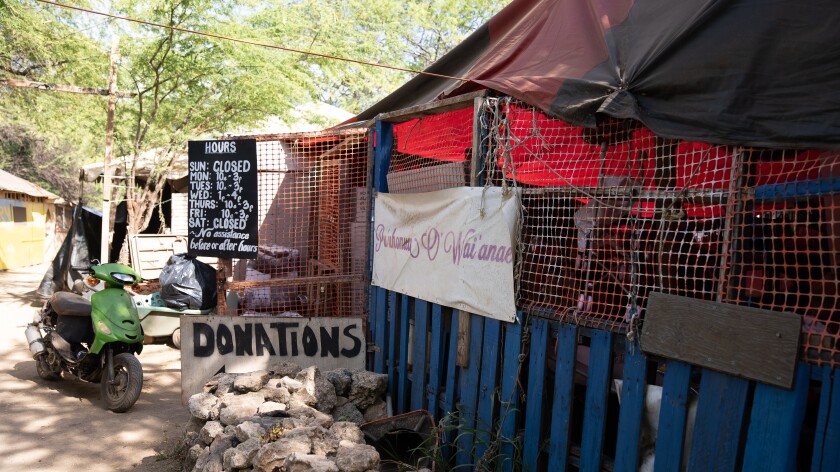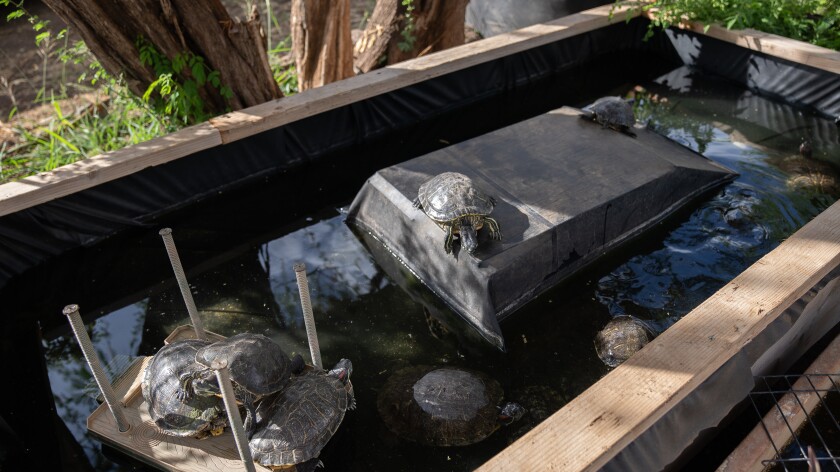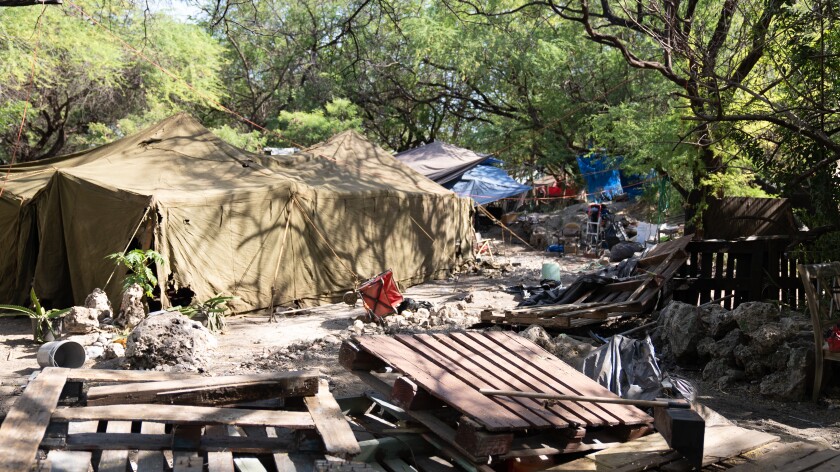Pu’uhonua o Wai’anae is a vital refuge for the houseless on Oahu’s west coast

Next to an unassuming pier in Waianae is a hand-built village of roughly 250 residents. These residents are houseless but not homeless, “[as] nearly all of the people of the village call Hawai‘i home but cannot afford a house here,” says the Pu‘uhonua o Wai‘anae website.
Pu‘uhonua o Wai‘anae (POW) is divided into two properties: the 19.5-acre Makai site by the pier and the 20-acre Mauka site, also known as the POW Farm Village, up in the hills. The majority of residents live in the Makai site. The website describes POW as a “self-governed village” and explains they have special permission from the local government to set up semi-permanent shelters there.

Makai: A growing sanctuary
The Makai village lacks electricity or running water, explains the website, and the porous ground makes it impossible to lay down foundations. The residents currently live in tents, though yards and fences are also built. Additionally, the village is divided into organized neighborhoods and sections. Village residents also help to maintain the nearby public bathrooms, says the POW website.
Two residents, a pair of sisters named Pia and Mata, said they have lived in the village for eight and five years, respectively. They grew up in Waianae and said, while there has always been some form of houseless encampment in the area, it has not always been as large and organized.
“This is a sanctuary,” said Mata. “[It] always has been. [We] always knew growing up. [We] had a cousin who used to live here. Nobody bothered [them].” Mata and Pia said they were evicted from their houses due to financial difficulties and an inability to pay rent, so they went to Waianae to live with cousins. Since then, POW has gotten bigger. “We have neighbors now,” Mata said.
“We watch out for our neighbors,” Pia added. She explained POW is a safe place to build a home and save money. “If you can respect yourself and others, and need a safe place to lay your head, this is a safe place,” she said.
“Waianae is a rough area,” Mata said. “Aloha is dying, [but] aloha doesn’t die in this village.” She said she has learned “a lot” while living in POW and plans to leave “eventually.”
“People aren’t just sitting [and doing nothing],” she explained. “If you’re in trouble, we have resources here. [You] don’t need people with a Ph.D. It’s in all of us to pull together.”
There are many resources within POW that help serve the community. Some of the resources include church services, after-school youth programs and a thrift store and pantry where all the items are free, explained Cathy Kawano-Ching, a friend of the village from the volunteer group Hui Aloha, which works closely with POW. She described the village as “organized by design over time,” in reference to the neighborhoods and individual plots where houseless people, including children and pets, live.
Each plot is built on by its residents according to their own needs. “You put up a tent and maintain yourself,” explained Pia.
Some POW residents are temporary while others consider POW to be a permanent home, said Kawano-Ching.
POW has guidelines to ensure the safety and stability of its residents. “Many people feel safer in [POW] than in a shelter [run by an agency] or the house they came from,” says its website. “The answers come not from the agencies, but from ohana,” the website states.

Mauka: A dream come true
Currently, POW is working to move from the Makai site by the harbor to the Mauka site. The Makai site is on state-owned land, whereas the Mauka site is privately owned by POW. Currently, only 17 people live on the Mauka property, said Twinkle Borge, the village’s leader. However, she said she hopes to change that soon.
The property was for sale for 10 years before she purchased it using money raised by POW with the help of the Dynamic Community Solutions nonprofit, said Borge. “I used to say I would buy it,” she said. “[Owning it] is like a dream come true.” On private property, village members will no longer need to fear being “swept,” or driven off public land by the police, she added.
However, before village members can move to the Mauka site, there is work to be done. The property contained “tons of rubbish” when purchased in 2020, and since then, Borge and others have been working on cleaning it up.
While that is under way, a tiny model home was also donated to the village as a prototype home to consider. An A-frame home was also designed and built as a prototype home.
Other models of home and construction materials are also being looked at, Kawano-Ching added. She explained the Mauka site, or POW Farm Village, is classified as agricultural land and has already started growing banana, ulu, papaya and coconut, and will be planting avocado and mango soon.
Borge said the Farm Village property also has power and water. “This is a place of healing, [and] it wakes up people’s mana.” She described the process of cleaning and preparing the property as “waking up the land.”
Borge continued, “[If you] take care of Mother Earth, Mother Earth [will] take care of you.”
“I want to bring people home,” she added, referring to the eventual move from the Makai site to the Mauka site.

A place of refuge for all
Borge has been houseless by choice for 19 years and said she “finds [her] mission better on the streets than being at home.” She said she is “amazed” by the people she has met while working with Oahu’s houseless population; many come from a background of addiction or domestic violence. In fact, Borge said, she has seen high schoolers teaching older residents how to read and write.
Borge said, “Each city should have a pu’uhonua [place of refuge].” While she does not consider villages such as these to be the “100 percent” solution to houselessness, she says it is a big part of it. Borge attributes this to how everyone in POW is “a part of what they’re creating.”
Additionally, the POW village is able to operate at a fraction of the cost of an agency-run shelter. On its website, it says an agency-run shelter of similar capacity would cost $7 million to build and $2 million to run annually. Additionally, the stability of POW allows its residents greater access to medical care outside of the emergency room.
The POW Farm Village is a refuge for animals as well. Borge takes care of several animals, including 17 turtles, two red-footed tortoises and multiple sulcata tortoises, including one over 20 years old named Oogway.
Borge said when the local Humane Society gets a turtle or tortoise, they call her. She said she hopes one day they will be able to roam the Mauka property. Sulcata tortoises in captivity can live upwards of 70 years and reach sizes of over 100 pounds, according to Reptiles Magazine. Many are abandoned by their owners as they become too large, or the owners become too old. Borge provides refuge for these animals as well.
POW has a GoFundMe currently running for developing the Farm Village.
